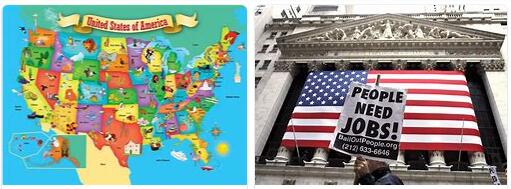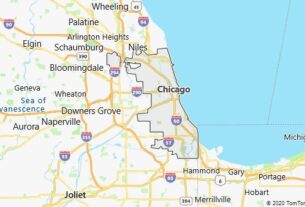This was followed by the simultaneous intervention of the government, forced to launch several measures and support the economy, made vulnerable also by the incidence of public debt and by the fluctuations of the financial system. At the same time, the growing internationalization of the US economy, which between the end of the 1990s and the early 2000s opened both the productive apparatus and the financial system to the increasingly intense action of foreign capital, further aggravated the economic scenario by denouncing the decline in the competitiveness of US companies. Precisely in this area, however, some rather significant fundamental transformations have been recorded. United States is a country located in North America according to EHISTORYLIB.COM.
On the one hand, the significant increase in trade in NAFTA, mainly attributable to the transfer of many US production plants abroad, especially in Mexico, in order to benefit from lower labor costs. On the other hand, in conjunction with the growing weight of Asian countries in trade, the intensification of relations with the Pacific States, towards which the commercial axis seems to be moving (and with it, also the evolution of production structures, the economic scenarios and the transformation of the US territory). American attention was therefore concentrated on the signing of bilateral agreements and negotiations within the APEC, despite the fact that the scenario of the balance of power in the Asian area has progressively become complicated: if, in fact, in the Eighties, the greatest economic rival of the United States was Japan, starting from the new millennium it was China that assumed the role of maximum competitor on a global scale, according to paths of economic globalization that resulted in forms of delocalization in some ways atypical compared to the past: it was the same American industries that were taken over by Asian multinationals, whose penetration into the American economy was such as to arrive at to plant the headquarters of their companies in the heart of the system. The most emblematic case was certainly the one involving IBM, the IT giant, which in 2004 sold to LENOVO, state-owned Chinese company, all of its hardware business, including 1000 employees (of which 400 relocated directly to China). The picture outlined by the new corporate structures is also aggravated by a fundamental difference with respect to past economic rivalries, since, if the American government had been forced towards Japan to adopt protectionist measures in order to protect the markets, this attitude towards China closing is not strategically functional. The Asian power represents, in fact, for the United States a threat and a resource at the same time: closing the borders would mean damaging in the first place the American multinationals themselves (from Nike to Motorola, to name but a few) which in turn have relocated factories to China. Without forgetting the fact that more than any other highlights the sense of economic interdependence between these two countries: the very core of the American economy, in the form of Treasury bills, is kept in the Chinese coffers, to cover the ever-increasing American debt.. In terms of trade, the European and intercontinental fronts proved no less problematic: if in 1998 the European Union substantially rejected the hypothesis of a “transatlantic common market”, the South American countries of the MERCOSUR they have shown little inclination to accelerate the process of commercial integration between the two subcontinents and the African countries themselves have coldly accepted the proposal for a US partnership, despite the offer to reduce their debts. The combination of these mistrust has caused the re-emergence, in the USA, of protectionist pressures that have never actually subsided.
On the domestic front, another aspect that turned out to be structurally negative was the growing inequality in the distribution of wealth, which led, on the one hand, to a progressive enrichment of increasingly limited income brackets and, on the other, to a progressive impoverishment of income brackets. weaker income, which ended up incorporating even what was once considered the middle class. On the other hand, it was and is the expansion of the American labor market itself to appear overestimated compared to reality: the statistical procedures adopted in the United States tend to consider as employed all those who have carried out, in a given period of time, some paid activity, regardless of the continuity of work, the formalization of the relationship or the salary level. Even apart from this particular aspect (which, however, heavily modifies the statistical surveys), the US labor market has registered a very strong push towards an increasingly pronounced mobility of workers, in the sense that the new employment relationships activated are of a temporary nature, when not precarious, with a lower remuneration than the average of old jobs, with the consequent progressive depletion of salaried workers (without counting the reductions in progress on social spending, which indirectly act in the same direction). These delicate internal balances were further shaken by the armed interventions in Afghanistan (October 2001) and Iraq (March 2003), which further aggravated the economic scenario, characterized, in 2003, by a deficit equal to 5% of GDP and a debt private and public equal to 200%. At the same time, the weight of some corporate scandals – first of all the one that hit Enron in 2002, one of the major multinationals active in the energy sector, the protagonist of a resounding failure, followed by a series of processes to ascertain the political and economic responsibilities of this collapse, in turn, due to mass layoffs and a chain reaction effect, which involved several companies linked to the credit institutions that had financed the multinational – further cracked investor confidence, with the consequent flight of capital, from on the one hand, and the use of tax cuts, incentives for businesses and a reduction in the cost of money to support consumption, on the other.
Despite a fluctuating trend observed between 2005 and 2007, characterized by conflicting signals, the current account deficit continues to show a growing deficit (6.5% of GDP in 2006), also due to the massive increase in imports. Moreover, the persistence of certain conditions, such as the progressive loss of value of the dollar (especially to the advantage of the euro), the subprime, the credit instruments granted to subjects with previous insolvency problems) have strongly highlighted the increasingly close dependence of the country’s economy on financial markets. To further confirm these delicate balances, in the autumn of 2008, what has been defined as one of the most serious crises connected to this sector, which has overwhelmed 4 of the largest US financial companies (Fannie Mae and Freddie Mac, companies specializing in mortgage lending; Lehman Brothers, investment bank; Aig – American international group, insurance agency, the latter beneficiary of a rescue maneuver worth 85 billion US dollars prepared by the American government itself). This crisis was triggered by the mortgages at high risk (so-called mortgage subprime), granted to the most vulnerable, the resulting massive write-downs of real estate securities and excessive exposure, accumulated by the financial market and linked to the real estate market in a more or less direct, through titles derivatives (especially Swaps) based on the performance of the market itself.



